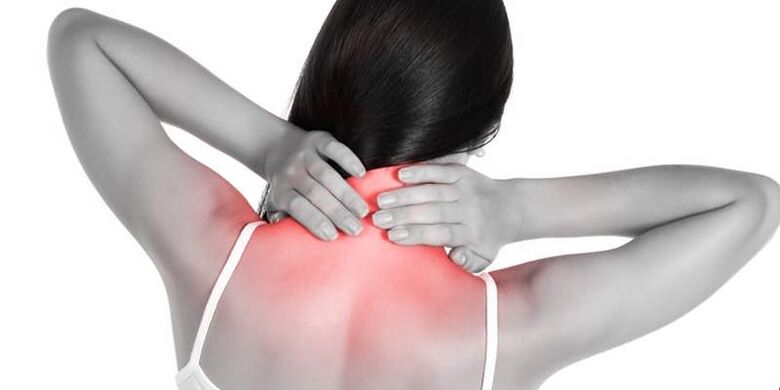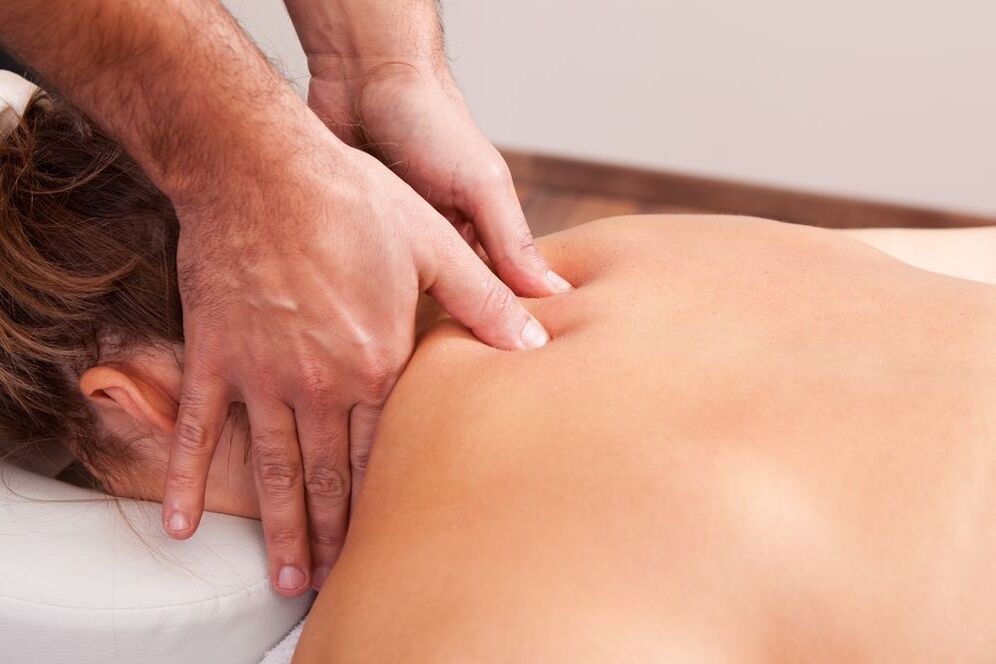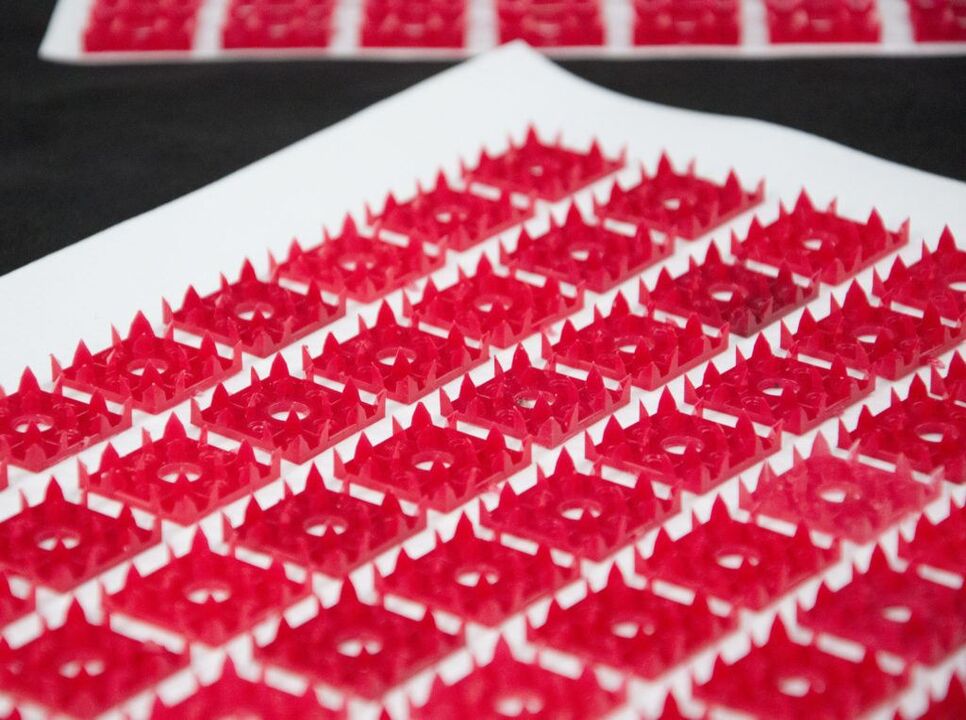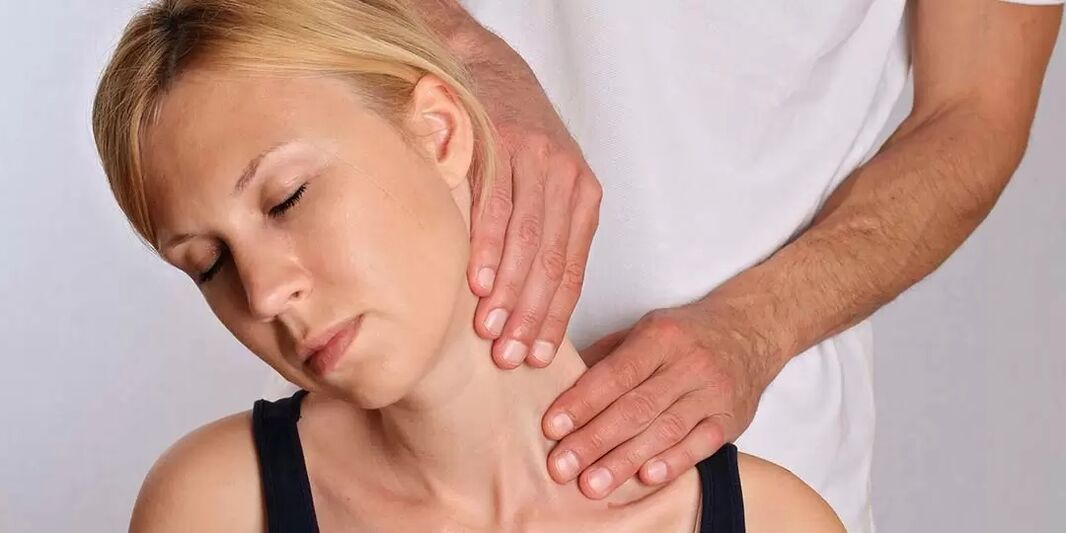
Cervical osteochondrosis is a type of dystrophic change in the intervertebral discs of the neck.
Not only are the discs themselves negatively affected, but also the vertebrae, soft tissue and cartilage. The main characteristic of the cervical region is the fact that its vertebrae do not have the most reliable structure compared to other regions, which makes this area very vulnerable. The vertebrae are located close to each other, as well as the arteries that supply the human brain.
If there is a displacement of the vertebrae, then there is a high probability of compression of the nerve bundles and arteries, which will inevitably lead to the occurrence of a hernia between the vertebrae and protrusion, that is, changes in the structure of the vertebral disc.
What is it?
Osteochondrosis of the cervical spine (Osteohondroz) is a degenerative-dystrophic lesion of the intervertebral discs, as a result of which the discs, vertebrae, and joints of the cervical spine are themselves damaged, and a decrease in the height of the intervertebral discs is observed. The disease progresses if left untreated and can cause headaches, poor circulation and even hernia. Like osteoporosis, the disease occurs due to a violation of mineral metabolism, as a result of which bones and joints become weaker.
Why does osteochondrosis appear?
Although traditional medicine considers degenerative changes in the intervertebral discs of the cervical spine to be a disease, from the standpoint of osteopathy, this is only a manifestation of deeper disorders in the body.
Thus, the real causes of cervical osteochondrosis are:
- muscle spasms. . . Spasmodic reactions of the muscles in the back, chest, and pressure can lead to certain parts of the body being very tense. As a result, the overall balance position of the body is disturbed, causing a change in the position of the spine. Deformities can touch the cervical region or other parts of the spine, causing osteochondrosis of the thoracic, cervical, and lumbar regions.
- poor posture. . . Scoliosis, stooping, rounded back, kyphosis and other postural disorders, even if minor, cause serious spinal imbalance. As a result, the load on the intervertebral discs is unevenly distributed, which causes their deformation and increased wear. The vertebrae start to converge, causing a violation of the nervous processes, cervical osteochondrosis develops very quickly. Postural disturbances caused by a change in the natural position of the ribs have similar consequences.
- innervation disorder. . . Decreased sensitivity of the nerve roots leads to pathological changes in their structure, in which the displacement and deformation of the cervical vertebrae go unnoticed by the patient. After all, pain is absent due to sensitivity disturbances.
- Internal Organ Diseases. . . The incorrect position of Organs internal organs, their displacement and lowering due to various dysfunctions lead to a violation of the general balance of the body. As a result, this acutely affects the position of the spine - the lumbar cervical vertebrae are displaced and deformed, leading to corresponding types of osteochondrosis.
- Violation of blood supply. . . Since the vertebral discs have no direct connection to the circulatory system, they receive nourishment from the surrounding tissues. Violation of the blood supply to the cervical spine leads to the discs not receiving enough fluid for rehydration (restoration of shape due to moisture absorption), renewal of cartilage tissue. As a result, its wear is accelerated, there is a reduction in the distance between the vertebrae of the cervical spine, leading to osteochondrosis.
Stages
The treating physician should determine the degree of development of cervical osteochondrosis, based on the history as well as the examination of the patient. There are only four degrees:
- First degree. . . The disease is at the root, the patient has a slight pain in the neck, which can be more intense if the person starts to turn their head.
- High school. . . The patient may complain of very severe pain in the cervical spine, which may be located in the upper limbs. The clinical picture shows that, at this stage of disease development, nerve bundles are pinched, causing severe pain. Headache, weakness and general malaise are also noted.
- Third degree. . . The pains become almost incessant, also radiating to the shoulder or arm. Some patients are diagnosed with a herniated disc, which leads to loss of sensation in the upper limbs. On medical examination, a noticeable decrease in cervical spine mobility is noted, as well as pain on palpation.
- fourth degree. . . At this stage of the disease, the intervertebral disc is almost completely destroyed. In its place, connective tissue appears, which leads to a worsening of the patient's condition. He begins to experience more pain, noise in his head, as well as poor orientation in space. This suggests that the artery is compressed, which interferes with the brain's natural nutrition.
first signs
How osteochondrosis of the cervical spine manifests itself:
- radicular syndrome - in the context of compression of the nerve endings, pain occurs, which spreads from the neck to the shoulder blades, forearms, covers the anterior wall of the chest;
- muscle weakness in the arms, noticeable swelling in the neck;
- when moving the head, a characteristic noise is heard;
- weakness, chronic fatigue, drops in blood pressure;
- lack of coordination, often dizziness, attacks are accompanied by nausea, vomiting;
- deterioration of vision and hearing, noise, ringing in the ears;
- numbness of limbs, tongue;
- frequent migraines;
- in women aged 45-65 years, during sleep, pain, numbness, tingling in the upper extremities appear, attacks may be repeated several times a night.
Symptoms of osteochondrosis of the cervical spine
Important symptoms of cervical osteochondrosis are dizziness, headaches and increased blood pressure.
Diagnosis of the disease is difficult, sometimes the pain does not appear and symptoms are erased, in addition, the uncontrolled use of strong analgesics masks the signs of the disease. A patient who does not feel pain considers himself healthy, and this continues until the development of irreversible processes in the tissues of the neck joints.
Headache with cervical osteochondrosis
The most common causes of headache in the condition we are describing:
- Vascular spasms of the brain;
- Compressed nerve roots;
- Reflex increase in intracranial pressure.
It appears that pain can be paroxysmal, constant, throbbing, and dull.
Dizziness with cervical osteochondrosis
Dizziness can result from:
- Inflammation in the middle or inner ear;
- Vascular spasms of the brain;
- Disturbances in the transmission of nerve impulses;
- Problems with the vestibular apparatus;
- Diseases of the cardiovascular system.
There are no clear criteria for dizziness in osteochondrosis. However, there are systemic and non-systemic vertigo, they have obvious differences.
Knowing the differences between systemic and non-systemic dizziness is recommended as this will help to independently determine the causes of an unusual condition:
- Systemic dizziness is a sensation of circular movement of surrounding objects or the body, which is a consequence of the disruption of the vestibular apparatus, visual analyzers and receptors in the joints, muscles and epidermis (osteochondrosis of various etiologies);
- Non-systemic dizziness is a feeling of dizziness, a feeling of lightheadedness, unsure of being in an upright position. In the case of non-systemic dizziness, the sensation of circular rotation is absent, which is an important difference between the signs compared.
A person who experiences dizziness of one of these types should be seen by an experienced physician first of all by a neurologist or (if otologic and nasopharyngeal disease is suspected) by an otolaryngologist.
The reason for emergency admission, not associated with osteochondrosis of the cervical spine, is the patient's identification (except dizziness) of signs such as:
- Paralysis of facial muscles and numbness of part of the shoulder girdle;
- Severe headache in a context of deteriorating health;
- Motor coordination disorders;
- Loss or extinction of consciousness.
Blood pressure in cervical osteochondrosis
The connection of cervical osteochondrosis with increases in blood pressure has long been established. The cervical vertebrae have important nerve endings and blood vessels.
A distinguishing feature of high blood pressure in cervical osteochondrosis is a combination of the following symptoms:
- Headache;
- Pain in limbs and chest;
- Decreased sensitivity in the neck area;
- The occurrence of pressure spikes after stress, muscle tension, prolonged uncomfortable posture, and other similar situations.
These signs must be taken into account when differentiating hypertension from various origins.
Sudden increases in blood pressure and a rapid deterioration in health are the basis for seeking emergency medical help.
Osteochondrosis Syndromes
Osteochondrosis consists of the following syndromes:
- Vertebral. . . It is also called vertebral, which indicates that bones and cartilage tissue are involved in the pathological process. This leads to the formation of such symptoms: limitation of neck motor activity, pain when rotating it, radiological changes in the image of the cervical spine. It is the simultaneous appearance of these signs that is the vertebral syndrome. A similar set of clinical signs is seen in myositis (muscle tissue pathology), and painful movements accompany many other conditions.
- heart syndrome. . . It manifests itself as a burning sensation in the chest region, the appearance of shortness of breath. The person feels the heartbeat accelerated, is tired and irritated. This condition is also typical of cardiac pathology, eg angina pectoris, coronary syndrome, heart attack. A precise conclusion about the causes of such symptoms can be made after the patient has undergone an ECG.
- root syndrome. . . The cervical region innervates 8 pairs of nerves, each of which has roots - the place where the nerve exits the vertebra. When they are involved in osteochondrosis, the patient feels a decrease in sensation or vice versa - intense pain. There may be numbness in the occiput, if it is painful, decreased sensitivity of the tongue, behind the ear, pain in the supraclavicular region. Sometimes there are swallowing violations, movements in the waist of the upper limb, numbness of the fingers.
Diagnosis
If there are clear signs of cervical osteochondrosis on the face, your doctor prescribes a few methods to make sure the diagnosis is correct:
- X-ray of the cervical spine. This method is advisable in the early stages of the disease, but it can be useless in advanced forms.
- CT (computed tomography). It allows you to see structural changes in the vertebrae, but using this method it is impossible to determine the size of the hernia between the vertebrae.
- Magnetic resonance. It is considered the most effective diagnostic method in determining cervical osteochondrosis. It is possible to determine the size of the hernia between the discs, as well as the degree of its development.
- Your doctor may also order a duplex scan to determine if your arteries are not working properly.
Disease complications
What is the danger of cervical osteochondrosis:
- frequent migraine attacks;
- heart rhythm disorder, atherosclerosis;
- protrusion, intervertebral hernia, vertebral bony growths;
- serious brain pathologies;
- narrowing of the vertebral artery lumen, which leads to the development of VSD, cerebral hypertension, deficiency;
- spinal effusion.
First aid at home with exacerbation of osteochondrosis
For severe pain, analgesics can be used. If pain relievers do not provide relief, NSAIDs can be taken.
Often used are means of "distraction", for example, a pepper patch, which does not heal but only warms the inflamed area and distracts from the pain. In case of swelling in the area of inflammation, the patient can drink an infusion of herbs or a diuretic for 3-4 days. Can osteochondrosis be cured by these methods? These measures are temporary; to treat the causes, you need to see a doctor.
How to treat cervical spine osteochondrosis?
In the initial stage of development, osteochondrosis can be cured without medication, just review the diet, daily routine and regularly perform a series of special exercises. In advanced forms of the disease, effective treatment is only possible with the use of various drugs that help stop the degenerative changes in the vertebrae.
The complex of therapeutic measures should include physical therapy - drug electrophoresis, ultrasound, magnetotherapy, laser therapy. These methods help to deal with pain, inflammation, tissue swelling, improve metabolic processes and blood circulation.
drug treatment
The main treatment methods for osteochondrosis of the cervical spine are drug treatment, physiotherapy, massage of the cervical collar area, and therapeutic exercises for cervical osteochondrosis are especially effective. The main groups of medications used for this disease include:
| Name | operating principle |
| Non-steroidal anti-inflammatory drugs (NSAIDs). | They reduce pain, help relieve aseptic inflammation and swelling of the damaged nerve root. |
| Medicines that improve the rheological properties of blood and blood flow. | Improves nutrition of damaged nerve roots and improves blood flow to the brain. |
| Vitamins B. | Improves metabolic processes in nervous tissue. |
| Muscle relaxants. | They are medications that relieve muscle spasms. |
| Chondroprotectors. These are glucosamine and chondroitin. | These are drugs that restore cartilage tissue, including the damaged intervertebral disc. |
When taking pills for osteochondrosis, it should be remembered that a significant effect of drug treatment with pills will only be if you combine it with other methods, including exercise. It should also be noted that the treating physician should prescribe how to treat the disease based on its stage and other signs.
Many doctors consider the treatment of cervical osteochondrosis with injections effective, as it allows faster action on the nerve endings and causes a minimum of side reactions. At the same time, it is better to take vitamins in pill form as there is no difference in assimilation but injections can be painful.
Injections used for treatment:
- intramuscular injections have a general strengthening and anti-inflammatory effect;
- the blocks are injected directly into the affected area, which leads to a quick effect.
Ointments and gels for external use
This is the most affordable group of medicines for home use. They are divided into inflammation relief, warming and pain relievers.
In cervical osteochondrosis, not all ointments are effective, in addition, due to their availability, they are sometimes used irrationally and without taking into account the peculiarities of the pathogenesis. Before using any medication, you should be examined by a doctor.
exercise therapy
Physical therapy for cervical osteochondrosis should be performed without acute exacerbation. The greatest efficiency of this technique is during the recovery period. There should be no discomfort and pain while running the complex!
| Exercise number 1 | Lying on your stomach, place your hands on the floor, lift your head and torso, your back should be straight. Stay in this position for 1-2 minutes. Slowly lower yourself to the floor. Repeat 2-3 times. |
| Exercise number 2 | Lying on your stomach, stretch your arms at your sides, turn your head to the left, try to touch the floor with your ear, then turn your head to the right. Repeat 6-7 times in each direction. |
| Exercise number 3 | In a sitting position, as you inhale, lean forward and try to touch your chest with your head; then exhale, bend back and tilt your head back. Repeat 10-15 times. |
| Exercise number 4 | While sitting, place your palms on your forehead, apply pressure with your palms to your forehead and your forehead to your palms. Continue this exercise for 30 seconds. Repeat 2-3 times. |
| Exercise number 5 | Rotate your head slowly, first in one direction, then the other. 10 rotations in each direction. Watch out for dizziness. When it appears, the exercise stops. |

Massage for cervical osteochondrosis
Massage should be done carefully, without undue effort. Inexperienced and unprofessional massage can end in failure. The movements should extend to the cervical region, collar area and part of the back. Massage is performed in the prone position, in extreme cases, in a sitting position.
The techniques are based on the following techniques:
- Caressing. Impact on the superficial layers of the skin. With the palms of your hands or fingertips from the head to the upper third of the middle of the back. The caresses at the base of the neck can also be zigzag;
- Squeezing. Impact on the deep layers of the skin in the upper third of the back. The fingers (thumb and index finger) along the neck make movements to grip the skin, which resemble squeezing. This is done carefully, the tissues close to the vertebrae are not involved;
- Crushing. The purpose of the procedure is to warm the skin and increase blood flow in the neck region. This is done with extreme caution. Impact on the spinous processes of the vertebrae is not allowed. Friction can be replaced by movements that resemble circular sawing or caressing;
- Crumple. It is of limited importance as it affects very deep tissues, which can aggravate the pathology.
Self-massage for cervical osteochondrosis is performed sitting in a comfortable position. Methods of petting, circular rubbing on the neck or shoulders are used. It is advisable to combine the self-massage method with the application of various ointments that increase blood flow and relieve pain in the crushed area.

Physiotherapy
Along with taking medications, the patient needs to undergo physical therapy procedures. They increase the effectiveness of medications and promote the restoration of joints and intervertebral discs.
- Electrophoresis - anesthetic ions penetrate the painful site due to the action of an electrical current.
- Laser therapy - has anti-inflammatory properties, ensures improved blood circulation, through exposure to light.
- Magnetic therapy - relieves tissue swelling, has an analgesic effect.
- Ultrasound - there is improvement in metabolic processes, relieving pain, relieving inflammation in damaged areas.
Several procedures are used in the form of physical therapy. The doctor prescribes the treatment, counting on the indications and in the absence of contraindications.

folk remedies
Alternative treatment should be used as an adjunct to drug therapy and physical education; unconventional methods will not help to get rid of the disease completely.
What to do with cervical osteochondrosis at home:
- Pour boiling water over a fresh horseradish leaf, let it cool a little, secure from the inside to the neck, secure with a fine natural cloth. The procedure is done before going to bed, leave the compress overnight.
- Grate raw potatoes on a fine grater, mix in equal proportions with hot liquid honey. Use the compress mixture, the procedure should be done 1 to 2 times a week.
- Mix a raw egg with 100 ml of sunflower oil, 20 ml of vinegar and 20 g of flour, remove the mixture in a dark place for 48 hours, remove the skin from the surface. Means to stain the inflamed area before bedtime, store in the refrigerator.
- In May, collect pine buds up to 2 cm long, cut into thin slices and fold in a dark glass container. For 1 part of the raw material, take 2 parts of sugar, remove the medicine in a dark place for 2 weeks. Drink 5 ml of the mixture three times a day, do not swallow it immediately, hold it in your mouth for 2-3 minutes. Course duration - 15-20 days, repeat 2-3 times a year.
- Grind 150 g of peeled garlic and 400 g of cranberries, place the mixture in a glass container, add 800 ml of honey after 24 hours, mix. Take 5 ml of the medicine three times a day before meals.
Deal with severe pain, remove excess salts with a cabbage leaf greased with honey, fix the compress on the neck with a warm handkerchief, leave overnight.
Applicator
The use of applicators is one of the methods of therapy for spinal diseases, including osteochondrosis.
The impact of the device on the cervical spine normalizes metabolic processes, relieves pain, increases muscle tone, improves blood circulation, increases the conductivity of nervous tissue, etc.

Manual therapy
Manual therapy is based on the principle of restoring motor functions and mobility between the vertebrae.
Initially, the manipulations consist of a light relaxing massage, then the doctor applies more and more force, acting on the vertebrae by pressing and turning the neck.

Surgery
The spine is the foundation of the entire human body. When diagnosing any pathology associated with the spine, specialists try to therapeutically eliminate it. Any operation on the column is fatal.
With cervical osteochondrosis, surgical intervention is allowed under the following indications:
- intervertebral hernia, spondylolisthesis, spinal stenosis;
- lack of therapy results when exposed for more than six months;
- the formation of osteophytes.
Modern medicine offers many ways to perform surgery with minimal risk to the patient's health and life.
Prophylaxis
Cervical osteochondrosis is a disease that develops, above all, with an inadequate lifestyle. Thus, disease prevention is a healthy lifestyle.
It is possible to reduce the risk of developing OHS if:
- exclude provocative factors;
- exercise regularly;
- do not resort to heavy physical activity;
- get rid of bad habits;
- try to be as nervous as possible;
- eat right.
Following preventive measures will help speed up the healing process and eliminate the likelihood of relapse. Elderly people and people with a hereditary predisposition are advised to constantly adhere to prevention. Adhering to a diet, performing simple exercises, will certainly bring a positive result. It is also useful to do yoga and swimming.



















